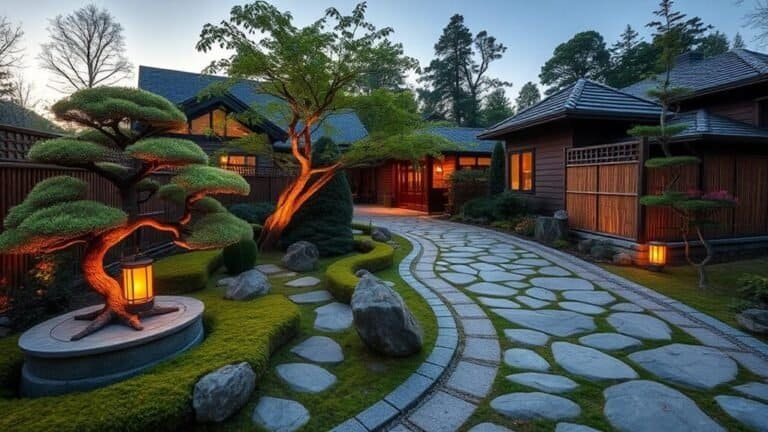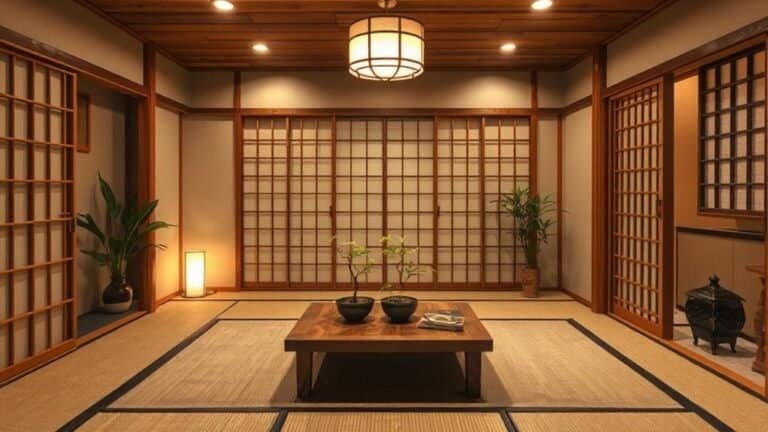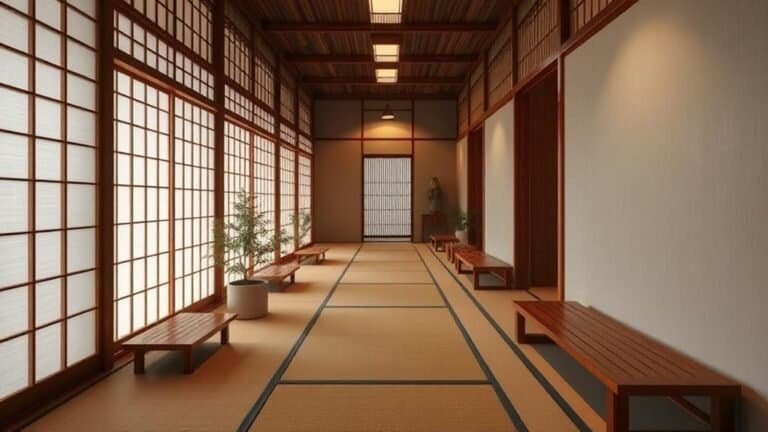To create a Japanese-style playhouse decor, focus on simplicity and natural elements. Use materials like wood, bamboo, and soft fabrics to craft a serene space. Choose a muted color palette with soft greens and creams for a calming effect. Incorporate traditional patterns on cushions and wall hangings to celebrate the culture. Add cozy touches like tatami mats and floor cushions for comfort. Light the space with paper lanterns or minimalist lamps to create an inviting atmosphere. Don't forget to include indoor plants, adding life and connection to nature. You'll find even more inspiring ideas to enhance your decor!
Key Takeaways
- Emphasize minimalism by selecting functional, beautiful furniture like low tables and floor cushions to create a serene play environment.
- Use soft, earthy color palettes and natural materials such as wood and bamboo to promote tranquility and connection with nature.
- Integrate traditional Japanese patterns in textiles and decorative elements to add cultural richness and visual interest to the playhouse.
- Incorporate indoor plants and sensory elements like pebbles and water features to enhance exploration and foster creativity among children.
- Personalize the space with DIY art projects and crafts, allowing children to express themselves and connect with their surroundings.
Understanding Japanese Aesthetics
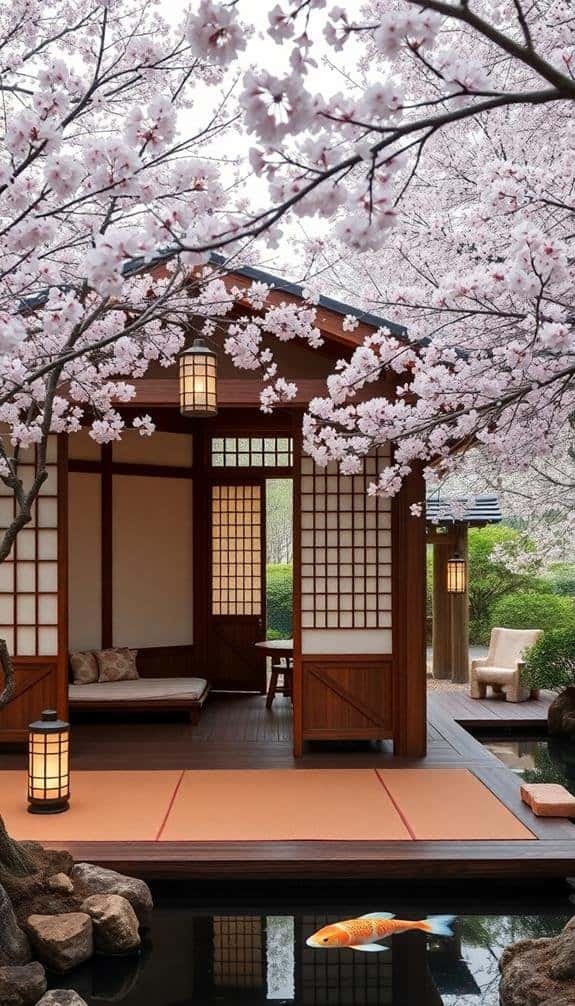
Japanese aesthetics is deeply rooted in simplicity and nature, reflecting a unique harmony that can inspire your playhouse decor. To truly embrace this style, focus on creating a serene environment that invites creativity and calmness. Start by incorporating elements that celebrate minimalism, such as Japanese style playhouse decor that emphasizes functionality without sacrificing beauty. Choose a few well-selected pieces that serve both function and beauty, avoiding clutter that can overwhelm the senses.
You'll want to pay attention to colors, too. Soft, earthy tones can evoke tranquility and a connection to nature. Think about using shades like muted greens, browns, and creams, which can create a peaceful atmosphere conducive to play and exploration.
Incorporating natural light is essential. Position your playhouse to take advantage of sunlight, allowing it to illuminate your space beautifully. You might also consider using simple, unobtrusive window treatments that let in light while maintaining privacy.
Lastly, don't forget about textures. Integrate materials that feel good to the touch—smooth wood, soft fabrics, and even pebbles. This tactile variety can engage your child's senses, enhancing their experience as they play. By weaving these elements together, you'll create a playhouse that embodies the essence of Japanese aesthetics.
Choosing Natural Materials
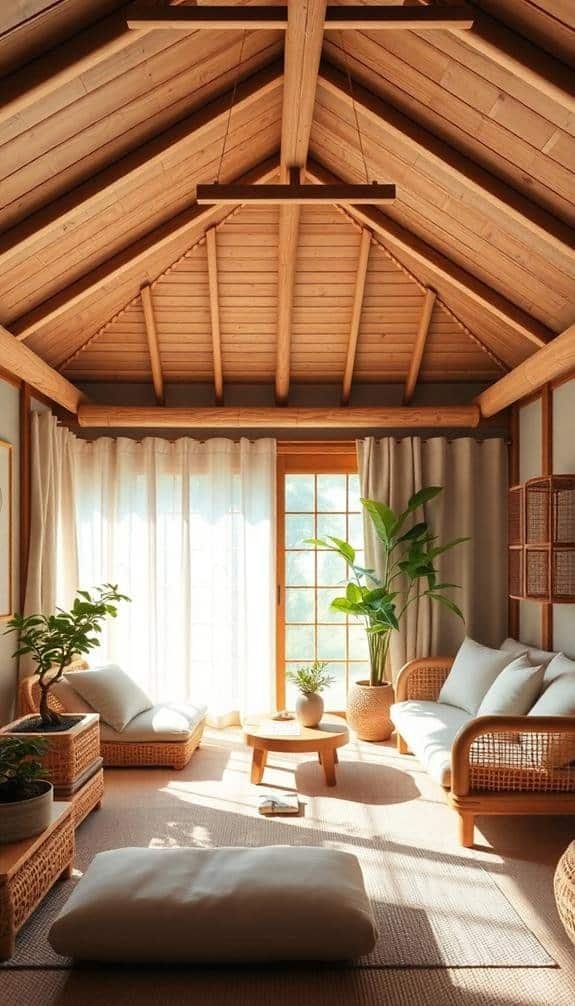
When you're designing a Japanese-style playhouse, opting for natural materials is key to achieving that authentic look and feel. These materials not only evoke the beauty of nature but also create a warm, inviting atmosphere. Think about incorporating wood, bamboo, stone, and textiles made from natural fibers. Each of these elements can transform your space into a serene escape, encouraging imaginative play.
Here's a quick comparison to help you choose the right materials:
| Material | Benefits |
|---|---|
| Wood | Durable, versatile, and eco-friendly |
| Bamboo | Strong, lightweight, and sustainable |
| Stone | Natural, adds texture, and coolness |
| Natural Fabrics | Soft, breathable, and comfortable |
Using these materials, you can create a space that resonates with tranquility and simplicity. Consider reclaimed wood for flooring or bamboo for play structures; both offer unique aesthetics while being environmentally friendly. For textiles, look for organic cotton or linen to cover cushions and curtains. By prioritizing natural materials, you're not just decorating; you're fostering a connection to nature that enriches your child's play experience. So, jump in, and let your creativity flow!
Emphasizing Minimalism

Creating a serene environment in your playhouse goes hand in hand with embracing minimalism. To truly capture the essence of Japanese design, you'll want to strip away the excess and focus on what truly matters. Start by selecting a few key pieces of furniture that are functional yet beautiful, such as those found in Japanese treehouse decor. Think low tables and floor cushions that invite relaxation and conversation, rather than bulky furniture that clutters the space.
Next, choose a limited color palette. Soft, neutral tones work wonders in creating a calm atmosphere. Shades of white, beige, and soft gray can make your playhouse feel open and inviting. You'll find that a cohesive color scheme not only looks appealing, but it also promotes tranquility.
Incorporating Traditional Patterns

Incorporating traditional patterns into your playhouse decor can bring a rich cultural touch that enhances the overall aesthetic. You might consider using classic Japanese motifs like Seigaiha (waves) or Asanoha (hemp leaves) in your fabric choices. These patterns not only add visual interest but also tell a story steeped in history and symbolism. Additionally, incorporating elements from Japanese style porch decor can further elevate the ambiance of your playhouse.
To start, think about using patterned textiles for curtains, cushions, or even wall hangings. You could find beautiful fabrics featuring these designs, which can effortlessly introduce an innovative flair to the space. Don't shy away from mixing and matching patterns; just make certain that they complement each other to maintain balance.
Another fantastic way to incorporate these patterns is through decorative wall decals or stencils, which can transform plain surfaces into eye-catching focal points. If you're feeling crafty, consider painting these traditional patterns directly onto furniture or wooden toys, creating a cohesive theme throughout your playhouse.
Embrace the opportunity to celebrate Japanese culture while fostering creativity in your playhouse. By thoughtfully integrating these traditional patterns, you'll create an inviting, imaginative environment that inspires play and exploration.
Utilizing Soft Color Palettes

Soft color palettes play a significant role in establishing a serene and inviting atmosphere in your Japanese-style playhouse. By choosing soft hues like pale greens, muted blues, and gentle pinks, you create a calming environment that encourages creativity and relaxation. These colors mimic the tranquility found in nature, which is a core element of Japanese design. To enhance this effect, consider incorporating Japanese style yard decor that features these soft tones, as it can beautifully complement your playhouse aesthetic.
To implement this, start with your walls. A light, neutral base can make a small space feel more expansive. Then, consider accent pieces like cushions, rugs, or curtains in those soft tones. Not only do these accents add depth, but they also harmonize with the overall aesthetic.
You might also explore layering shades of the same color to create visual interest while maintaining a cohesive look. For instance, pairing a soft lavender with a lighter lilac can add dimension without overwhelming the senses.
Don't forget about the power of natural light! Soft colors reflect light beautifully, making your playhouse feel airy and bright. With these gentle palettes, your space transforms into a peaceful retreat that inspires play and imagination. So, embrace these tranquil colors and watch your playhouse flourish!
Designing Nature-Inspired Elements
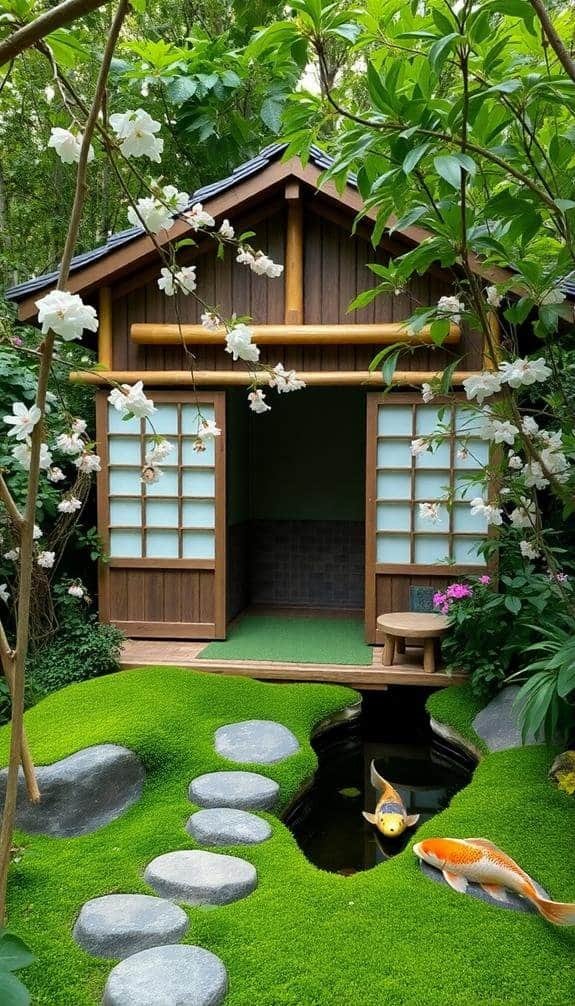
Nature-inspired elements can transform your Japanese-style playhouse into a harmonious retreat that connects children with the outdoors. Start by incorporating natural materials like bamboo or reclaimed wood for furniture and play structures. These choices not only add authenticity but also promote sustainability, teaching kids the importance of nature.
Next, consider adding a small indoor garden. You can set up simple planters filled with herbs or flowers, allowing children to interact with living plants. This not only brightens up the space but also encourages exploration and responsibility.
Use decorative items inspired by nature, such as soft cushions featuring floral or leaf patterns, or wall art depicting serene landscapes. These details help reinforce the theme and create a calming atmosphere.
Don't forget about lighting! Natural light is essential, so maximize window spaces or use lanterns that mimic the glow of fireflies.
Lastly, include sensory elements like pebbles, sand, or water features. These can provide tactile experiences that connect children to the natural world, turning playtime into an adventure. By thoughtfully integrating these nature-inspired elements, you'll create an enchanting space that sparks creativity and joy.
Creating Cozy Spaces

Creating cozy spaces in your Japanese-style playhouse can make it a welcoming retreat for kids. Start by incorporating soft textiles that invite relaxation. Use tatami mats or plush floor cushions for seating, encouraging kids to sit and engage in imaginative play. Layering rugs can add warmth and comfort, creating a nurturing atmosphere.
Next, consider lighting. Soft, ambient lighting can transform a space, making it feel more intimate and inviting. Use paper lanterns or string lights to create a magical vibe, perfect for storytelling sessions or quiet moments of reflection.
Incorporate natural elements too. A small indoor plant or a touch of greenery can breathe life into your playhouse, making it feel more connected to nature.
Don't forget about the décor. Hang simple artwork or crafts made by the kids themselves, showcasing their creativity while adding a personal touch.
Selecting Appropriate Furniture

To enhance the cozy atmosphere in your Japanese-style playhouse, selecting appropriate furniture is key. You want to create a space that feels inviting and authentic. Here are some ideas to inspire your choices:
- Tatami Mats: Start with traditional tatami mats for the flooring. They add warmth and a unique texture, making the space feel grounded and serene.
- Low Tables: Invest in a low wooden table, ideal for sitting on the floor. It encourages relaxation and makes for a perfect spot for playtime or sharing snacks.
- Floor Cushions: Add plush floor cushions or zabuton for comfy seating. They not only provide comfort but also enhance the Japanese aesthetic, inviting everyone to gather and enjoy.
- Sliding Shoji Screens: Consider incorporating shoji screens to create flexible spaces. They can partition areas or serve as a beautiful backdrop, allowing you to play with light and privacy.
Adding Cultural Touches
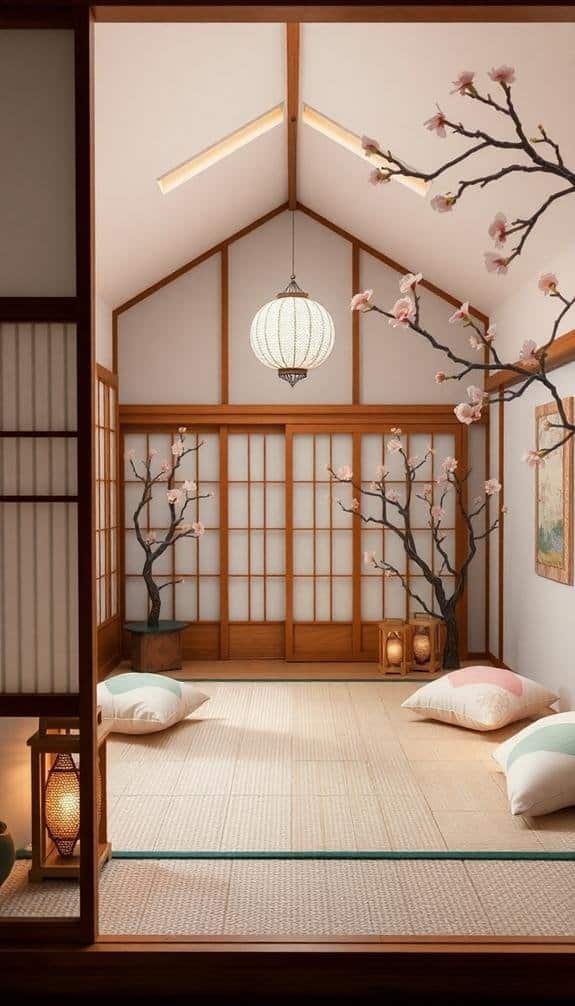
Incorporating cultural touches into your Japanese-style playhouse can elevate the overall ambiance and authenticity of the space. Start by adding decorative elements like origami creations or handcrafted calligraphy pieces. These unique artworks not only reflect traditional Japanese aesthetics but also inspire creativity in your little ones.
Next, consider textiles. Use tatami mats or floor cushions made from vibrant fabrics, which can create a cozy, inviting atmosphere. You might also want to hang a noren (a traditional fabric divider) at the entrance. It adds a charming touch and sets the mood right from the get-go.
Plants can also enhance your playhouse. Incorporate bonsai trees or bamboo arrangements to bring nature indoors, reminding children of Japan's deep connection with the natural world.
Don't forget scents! A subtle hint of sandalwood or cherry blossom can create an immersive experience.
Incorporating Lighting Techniques

Lighting can really set the mood in your Japanese-style playhouse, so it's essential to choose the right techniques. Soft, ambient lighting can create a serene atmosphere, while innovative designs will elevate your space. Here are four techniques to contemplate:
- Paper Lanterns: Hang delicate, handmade paper lanterns from the ceiling. They diffuse light beautifully, casting a warm glow that evokes traditional Japanese aesthetics.
- Floor Lamps: Use minimalist floor lamps with rice paper shades. They add height and elegance, while also providing functional lighting for reading or playtime.
- Candlelight: Incorporate LED candles for a safe, flickering effect. Placing them on low tables or windowsills can bring a cozy, inviting feel without the worry of real flames.
- Accent Lighting: Contemplate LED strip lights under shelves or along pathways. They highlight architectural features and create a modern touch, enhancing your playhouse's unique vibe.
Using Indoor Plants

While you're creating a tranquil Japanese-style playhouse, adding indoor plants can greatly enhance the overall ambiance. These green companions not only bring life to your space but also embody the essence of nature, which is central to Japanese aesthetics. Consider incorporating plants like bonsai trees or peace lilies; they're both visually appealing and easy to maintain.
Position your plants strategically, perhaps on windowsills or low tables, to encourage a sense of harmony. Layering different heights creates visual interest while mimicking the natural landscapes found in Japan. Using natural materials for plant pots, such as bamboo or ceramic, can further solidify the theme.
Don't forget about the benefits of air-purifying plants, like snake plants or spider plants, which can improve air quality and create a healthier environment for play. You might also explore hanging plants to draw the eye upward, adding depth to your decor.
Personalizing With Art and Crafts
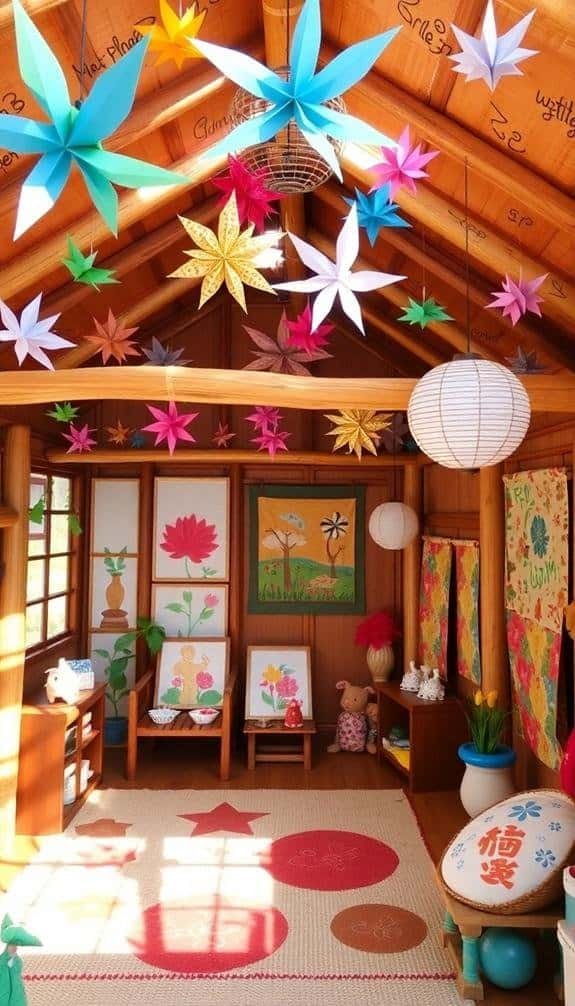
How can you make your Japanese-style playhouse feel truly unique? By adding personal touches through art and crafts, you'll create a space that reflects your style and imagination. Here are some innovative ideas to inspire you:
- Origami Decorations: Fold colorful paper into stunning shapes like cranes or flowers, and hang them from the ceiling. This adds a whimsical touch that echoes traditional Japanese artistry.
- Hand-Painted Murals: Consider painting a serene landscape or a favorite scene on one wall. This could be a tranquil bamboo forest or a blooming cherry blossom tree, bringing a slice of nature indoors.
- Custom Fabric Wall Hangings: Use fabric scraps to create wall hangings or banners. Choose patterns that reflect Japanese aesthetics, like traditional motifs or calming colors.
- Personalized Art Projects: Get creative with DIY projects, like making a family handprint tree or a collage of favorite memories, to add a personal narrative to your playhouse.
These ideas not only enhance your decor but also foster creativity and connection. Immerse yourself, have fun, and let your artistic spirit shine!


